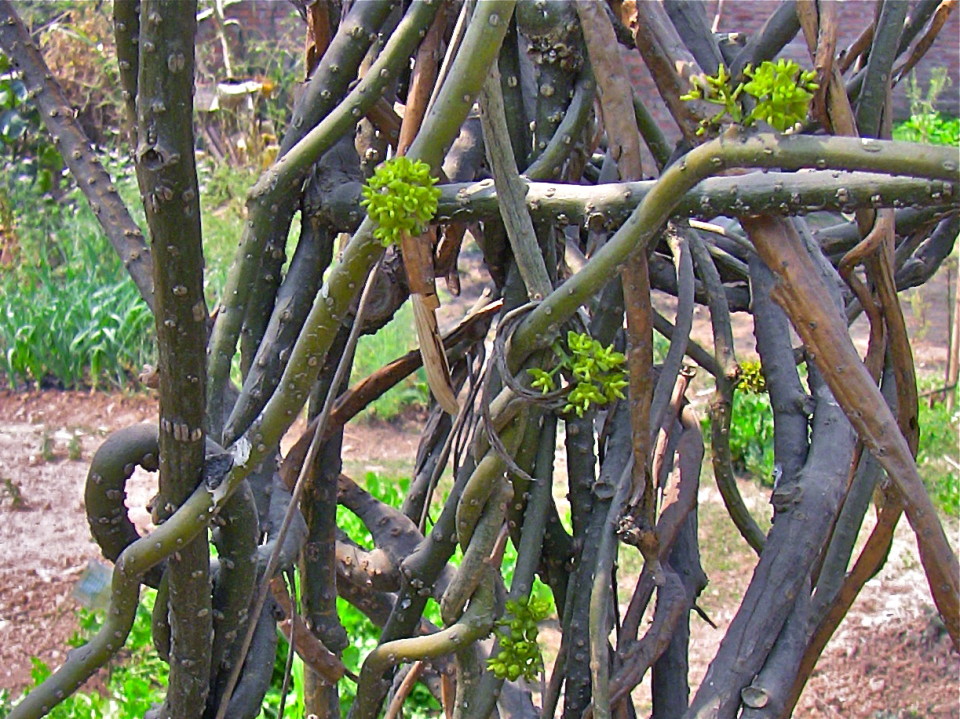
Botanical name: Tinospora cordifolia, Menispermaceae
Other names: Amṛta, ‘nectar’, (S), Gulancha, guḍaach (H), Amridavalli, Chintilikoti (T), Tinospora (E), Kuan jin teng (T. sinensis) (C)
Botany: Guḍūcī is a large deciduous perennial climber with large succulent stems and papery bark, sending down long, pendulous fleshy roots as it climbs. The leaves are glabrous and cordate, with 7-9 veins. Guḍūcī is monoecious with yellowish white flowers with six petals borne on racemes, the male flowers clustered in the axils of small subulate bracts, the female flowers usually solitary, with three carpels. The mature drupes are red in colour, marked with sub-basal style-scar (Kirtikar & Basu 1935, Warrier et al 1996).
Part used: Stem.
Dravyaguṇa:
• Rasa: tikta, kaṣāya, madhura
• Vipāka: madhura
• Vīrya: laṅghana, uṣṇa
• Karma: dīpanapācana, grāhī, jvaraghna, dāhapraśamana, kāsahara, kustaghna, hṛdaya, chedana, vajīkaraṇa, rasāyana, tridoṣahara (Dash 1991, Dash and Junius 1983, Kirtikar & Basu 1935, Srikanthamurthy 2001, Warrier et al 1996).
Constituents: Researchers have isolated a variety of constituents for Guḍūcī, including alkaloids, glycosides, steroids, and other compounds. Among the alkaloidal constituents are the isoquinolines berberine and jatrorrhizine, and aporphine-type alkaloids magnoflorine and tembestarine. Glycosides include the bitter tasting gilion, tinocordiside, tinocordifolioside, cordioside, syringin, syringin-apiosylglycoside, palmatosides C and F, cordifolisides A-E, and diterpenoid lactones (clerodane derivatives, tinosporon, tinosporidine, tinosporides, jateorine, columbin). Steroidal constituents consist of b-sitosterol, d-sitosterol, tingilosterol, hydroxy ecdysone, ecdysterone, makisterone A and giloinsterol. Other constituents include the sesquiterpenoid tinocordifolin, aliphatic compounds octacosanol, heptacosanol and nonacosan-15-one, a non-glycoside bitter principle called gilenin, and the polysaccharide arabinogalactan (Chintalwar et al 1999, Gangan et al 1994, Kapil & Sharma 1997, Singh et al 2003, Swaminathan et al 1989a, Swaminathan et al 1989b, Yoganarasimhan 2000).
Medical research:
• In vitro: immunostimulant (Kapil & Sharma 1997, Thatte et al 1994, Thatte et al 1992), antitumor (Jagetia et al 1998), anti-oxidant (Mathew & Kuttan 1997)
• In vivo: immunomodulant (Bishayi et al 2002, Manjrekar et al 2000, Nagarkatti et al 1994), antijaundice (Rege et al 1989), antidiabetic (Grover et al 2000, Prince and Menon 1999, Stanely et al 2001, Stanely et al 2000), hypoglycemic (Wadood et al 1992), anti-oxidant (Mathew & Kuttan 1997, Prince and Menon 1999, Stanely et al 2001), hypolipidemic (Stanely et al 1999)
• Human trials: Guḍūcī promoted a highly significant reduction in sneezing, nasal discharge, nasal obstruction and nasal pruritus in patients suffering from allergic rhinitis, compared to placebo (Badar et al 2005).
Toxicity: No data found.
Indications: Dyspepsia, vomiting, hypochondriac pain, flatulence, intestinal parasites, intermittent and chronic fever, burning sensations, cough, asthma, cardiac debility, hepatitis, jaundice, anemia, skin diseases, thirst, debility and weakness, gout, arthritis, disorders of the genitourinary tract, diabetes
Contraindications: Pregnancy.
Medicinal uses: According to tradition, Guḍūcī is said to have origination from the epic battle of the Rāmāyaṇa in which the God-king Rāma lays siege to the island of Lanka, home of the evil King Rāvaṇa. When Rāvaṇa is finally defeated King Indra is so pleased with the result that he sprinkles amṛta (nectar) on the bodies of the slain monkeys to bring them back to life. In all the places where the nectar dribbled down from the bodies of the monkeys, the Guḍūcī plant is said to have grown. For this reason Guḍūcī is also called Amṛta, but also because Guḍūcī is one of the best agents in the materia medica of India to treat āma conditions without aggravating or upsetting the doṣāḥ. To this extent Guḍūcī is tridoṣahara, the kaṣāya and tikta rasa pacifying pitta and kapha, and the madhura vipāka and uṣṇa vīrya reducing vāta. It is particularly suited in chronic debilitated conditions with autotoxicity, clearing the body of accumulated wastes (āma), stimulating digestion (agni), and restoring the energy systems of the body (ojas). It is widely used by physicians of Āyurveda for a variety of conditions, and finds its way into many different formulations, especially in the treatment of diabetes, in which it is often combined with Śilājatu. Guḍūcī is often used along with circulatory stimulants such as Śūṇṭhī in the treatment of āmavāta (rheumatoid arthritis), to reduce the symptoms of inflammation and pain. Although classified in many nighaṇṭus as warming in energy, the balance between its bitter and sweet tastes also makes Guḍūcī specific to disorders and deficiencies of the liver, blood, and skin, and to reduce the vitiations of pitta. Thus Guḍūcī is often used to treat liver disorders, including hepatitis and jaundice, as well as anemia. The Bhāvaprakāśa mentions a series of formulations called Guḍūcī ghṛta, the simplest forms prepared from a decoction of Guḍūcī dried herb or fresh juice, with ghṛta and water, in the treatment of gout, leprosy, jaundice, anemia, splenomegaly, cough and fever (Srikanthamurthy 2000). According to the Cakradatta a similar preparation made with sesame oil is used for a similar range of conditions, including itching and ringworm (Sharma 2002). In the treatment of all types of jvara or fever, with loss of appetite, nausea, thirst and vomiting, the Bhāvaprakāśa recommends a decoction called Guḍūcī kvātha, comprised of equal parts Guḍūcī, Dhānyaka, Nimba, Padmaka and Raktacandana (Srinkanthamurthy 2000). In the treatment of vomiting, the Cakradatta recommends a cold infusion (hima) with honey (Sharma 2002). As a rejuvenative the Cakradatta recommends Guḍūcyadi rasāyana, comprised of equal parts powders of Guḍūcī, Viḍaṅga, Śaṅkhapuṣpī, Vacā, Harītakī, Kuṣṭha, Śatāvarī and Apāmārga, taken with ghṛta as an anupāna. The Cakradatta states that this formula “…makes one capable of memorizing a thousand stanzas in only three days” (Sharma 2002).
Dosage:
• Cūrṇa: 3-5 g b.i.d.-t.i.d.
• Kvātha: 30-90 mL b.i.d.-t.i.d.
• Tincture: fresh stem, 1:2, 95%; 2-5 mL b.i.d.-t.i.d.